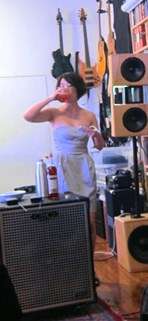|
Back
UnCage That Pianist! New York
Spectrum, 121 Ludlow Street
05/07/2013 -
Milica Paranosic: Bubble (World Premiere)
György Kurtág: Hommage à Scarlatti
Domenico Scarlatti: Two Sonatas
Orlando Gibbons: The Italian Ground
Nils Vigeland: I Turisti (World Premiere)
Michael Vincent Waller: Acqua Santa (World Premiere)
Maurice Ravel: Miroirs: «Une barque sur l’océan»
Claude Debussy: Préludes: «La Cathédrale engloutie»
Franz Liszt: La lugubre gondola
Marco Stroppa: Miniature estrose: «Ninnananna»
John Cage: Water Walk
Jenny Q. Chai (Pianist) 
J. Q. Chai pre-Cage (© Coco T. Dog)
On Manhattan’s most incongruous street, thronged with cool Paris bistros, Chinese dumpling shops, remnants of Russian Jewish markets, 50-flavor ice cream parlors, art galleries, Thai restaurants, a dazzling museum and the hippest clientele, up the steps to the second floor of a 135-year-old synagogue, is the most unlikely concert hall in the city.
Audiences in Spectrum lounge on sofas, folding chairs, armchairs or they stand. The dress code includes formal suits, shoeless/sockless feet, Steve Madden loafers, dresses, blouses or saris. They peruse the dense libraries holding everything from the great Alex Ross to the despicable Frances Fukuyama. On the walls are a dozen different guitars, a mandolin, an Indian veena, a Medieval sackbut, a light box and 21st Century electronic gear.
As well as a Steinway Grand. And it was the performer on this Grand, introduced as a “ brutal piano monster”, for whom this hip, straight, nerdy, geeky, electro-cool audience piled in last night.
Shanghai-born Jenny Q. Chai, internationally renowned for her eclectic choices, with partialities for composers who love to compose for her, is hardly “brutal”. When necessary, she plays Ravel and Debussy with a firm technique and excellent phrasing, albeit a sound which was engulfed by the resonating acoustics of Spectrum. (Her “Engulfed Cathedral” actually did sound like it was bubbling up with infinite overtones, from the depths of some fantasy ocean.)
But in a concert devoted to the ecology of water, many had come to hear her final work, John Cage’s rarely performed Water Walk, which was plainly the most boring work on the program.
The saving grace was that Water Walk (the title of which Cage had explained, “It has water, and I walk around”) was only about seven minutes long.

J. Q. Chai during Cage (© Coco T. Dog)
During those seven minutes, Ms. Chai, dutifully held her stopwatch, blew a few streamers, heated a pressure cooker for the steam, played a few radios (knocked off the table at the grand finale), drank a glass of Campari (hardly the wine which Mr. Cage had specified) and did other things.
It had amused a television audience half a century ago, but in the midst of this so vividly interesting apartment and audience, the Cage seemed particularly prosaic.
Especially because otherwise Ms. Chai is such an engaging pianist. For the “mainstream” water works, the dimensions of Spectrum may have precluded the mysterious isolation of Ravel’s boat on the ocean, but her technique in this most challenging work was superb. Liszt’s desolate The Gondola in the Funeral (my translation, since Liszt was inspired by a Venetian funeral procession) was given all the mystery which the Ravel lacked. This was Liszt at his most mystical, and the end–actually an infinite pause–was startling.
My favorite works were two pieces which not only deconstructed but pulverized familiar songs. One of György Kurtág’s homages, this to Scarlatti, was anything but Scarlattiana. Yet in the tiny piece, one heard bits and pieces of the hunting sonatas, a few notes which could have come from the Master’s works. It was peeking through a keyhole into a dark with a few unexpected flashes. And Ms. Chai solved the mystery right after with two rarely performed Scarlatti sonatas, played with crisp, brightly colored precision. And that was followed by a Gibbons work where Ms. Chai actually came near to imitating a harpsichord.
The second deconstruction was Nils Vigeland’s I Turisti, supposedly tourists speaking around two Roman edifices, marked by Three Coins in a Fountain and O Sole Mio. Those tourists were speaking so loudly on the piano, that perhaps my imagination filled in the gaps of those popular songs. But imagination was the key in a fantasy piece illustrative work of great imagination.
The first piece on the program was Bubble and Ms. Chai dutifully entered blowing bubbles from a pipe. It was played, alas, against some electronic sounds almost drowning out the piano. They may have been bubbles but sounds varied from Gargantuan toilet-flushing to radiators burping.
Michael Vincent Waller’s Acqua Santa was another piece that didn’t quite hit the spot. Starting with minuscule variations on three contiguous notes, it went onto other variations, ending with a Javanese-style pentatonic motif. Obviously ingenious on music paper, but not even Ms. Chai’s playing could overcome its dryness.

J. Q. Chai post-Cage (© Coco T. Dog)
But Marco Stroppa had written a lullaby (or anti-lullaby) called “Ninnananna” which I found delicious. Not meant to lull a baby to sleep, Ms. Chai played the moments between waking and sleeping which included physical gyrations, hints of nightmares, very loud chords and, I guess, final sleep.
“Ninnananna” could well have been called “Insomnia”, because nobody could actually relax. Which was the way Jenny Q. Chai arranged her program. The unexpected, the mysterious, unusual, and comic were all part of the show. But the artist herself has such easy expertise that each challenge (and each occasional failure) was joyfully arousing.
Harry Rolnick
|